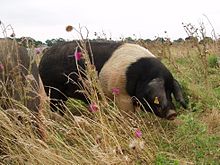Essex pig
This article needs additional citations for verification. (January 2022) |
 An Essex boar | |
| Country of origin | United Kingdom |
|---|---|
| Traits | |
| |
The Essex is a breed of
Characteristics
The Essex, in its traditional form, was a smallish pig with 'pricked' ears and a black ground colour, with a broad band of white 'sheeting' across the shoulders.
History
Like other old British pig breeds, the ancestor of the Essex may have originated in the county of the same name from selective breeding of local wild pigs.[
The Essex pig remained locally popular until as recently as the mid-1950s, and had actually increased in numbers during the
The position of the Essex breed changed markedly after the publication of a 1955 report by the Advisory Committee on the Development of Pig Production in the United Kingdom, chaired by Sir
While the breed societies of the
Re-creation of the breed
Later research showed that one farmer, John Croshaw, had refused to amalgamate his herd of Essex pigs (the "Glascote Herd"), which retained a pure Essex bloodline despite being officially registered as British Saddlebacks: Croshaw had carefully managed his stock to avoid inbreeding.[5]
References
- ^ Wiseman, J. The pig: a British history, Duckworth, 2000, p.45
- ^ The British Saddleback. British Pig Association. Archived 23 February 2008.
- ^ a b The Decline of Traditional Breeds. British Pig Association. Archived 27 February 2012.
- ^ Development of pig production in the United Kingdom: report of the Advisory Committee on Development of Pig Production in the United Kingdom, HMSO, 1955
- ^ Essex Pig Society. Archived January 2010.
